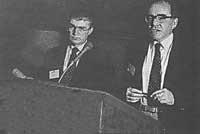Fusion, inexhaustible source of energy
1989/05/01 Legarreta, J. A. Iturria: Elhuyar aldizkaria
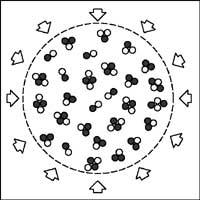
Nuclear fusion is the process of forming a heavier core by adding two light cores, releasing large amounts of energy. It provides the most energy from all the energy sources we know.
This huge amount of energy is due to the loss of mass in the reaction. But what is mass loss? The mass of atomic nuclei measured in the laboratory is less than the sum of the masses of their nucleons, known as proton and nucleon neutron, and this mass difference is called mass loss. For example, in the laborating assumption of 4 2 He mass 4.0015 amu (amu = unit. atomic mass = 1.66077x x10 -27 kg. It is the unit used to measure the mass of atoms).
For its part, the sum of the masses of its two protons and two neutrons is 4,032 amus. So, if we generated the helium core by combining its four components, we would have a mass loss of 0.0305 amu. Where is that mass? E = m obtained by ALBERT EINSTEIN to answer this question. We must go to equation c 2. This equation allows the generation of energy by mass and vice versa. According to the above equation, the mass of 0.0305 amu equals an energy of 28.3 MeV. The mass perding at generation of 4 2 He is liberated as energy.
When it was discovered that this mass loss produces energy, a melting research would have occurred. The experiments carried out in this field have been very numerous. In the nuclear mergers investigated, the most profitable is the intermediate between the deuterium of hydrogen and the isotopes of tritium, since it is the one that provides the most energy.
The problem we find in the research of fusion reactions is, among others, to overcome the electrostatic barrier. Let us remember that, according to electrostatic, the loads of the same sign repel each other, and the closer the two charges are, the greater the repellent force they suffer. Therefore, if you want to carry out the process of fusion of both nuclei it is necessary to overcome the repulsive force. For them we will need millions of degrees of temperature and a lot of pressure. In the case of the Deuterio-Tritium fusion reaction, for example, a temperature of 108ºC is required. Although researchers working at Fusion Research Centers are trying to reach high temperatures and pressures, the results are not satisfactory.
That said, the American physicist STEVEN JONES participated in the meeting convened by the “American Physical Society” on April 24, 1986, stating that, based on his experiments, he had managed to complete the fusion process at a temperature of about 100C. According to him, if we could replace the electron of one of the two hydrogen atoms involved in the fusion reaction with a particle called a muon, fusion would occur at a much lower temperature. Therefore, we could say that the fusion reaction is catalyzed by the muon.
The muon was found in cosmic radiation in 1936. The following table shows that the electron and muon are very similar.
This table shows the similarity between the muon and the electron.
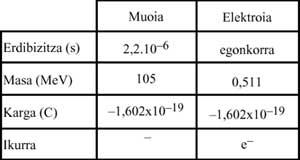
The muon is very unstable, as evidenced by the value of its half-life, 207 times heavier than the electron. For this last property it is known as heavy electron.
The truth is that what Jones proposes is not a new idea; about forty years ago F.C. of the University of Bristol. Physicist FRANK suggested that the muon could catalyze fusion.
Let's see what happens when replacing the electron with a muon. As is known, the radius of the atom is inversely proportional to the mass. Therefore, the hydrogen atom with muon would internalize about 200 times more than the electron atom and the muon would be much closer to the nucleus. As a result, the muon disguises the positive charge of the nucleus and the repellent force between this nucleus and another nucleus seems less intense, overcoming the electrostatic barrier more easily. Therefore, we do not need to heat up to high nuclear temperatures.
Although this method represents a breakthrough in the field of fusion, we should not think that we have cleaned up all the problems. The truth is that all that has been mentioned so far is theory and if it is put into practice it will have to give solutions to technological problems.
Let's see F.C. Frank explains the muon-catalyzed fusion reaction. The fusion process developed by Frank is developed in four steps:
- step: The muon expels the electron from the hydrogen atom from its orbit, forming hydrogen with muon.
- step: If there is a deuterium or tritium nucleus around the hydrogen atom with a muon, it would pass from hydrogen to deuterium or tritium, since taxing the muons around a heavier nucleus would be in an orbital of less energy. Let us remember that according to thermodynamics all physical systems, and in our case muons, tend to a state or level of less energy. So we got a deuterium with muon.
- step:
Since the hill is very close to its current core, its negative charge disguises the positive charge of the core, more easily to overcome the electrostatic repellent force. Then deuterium with muon and some nearby hydrogen atom could collide with each other. As a result of the collision, the electron of the hydrogen atom would be expelled by the muon and through it deuterium and proton would be joined to form the mesomolecule.
Both cores are very close to each other and are vibrating, so they are in an excellent opportunity to overcome the electrostatic barrier and merge. - step: In this
last step, represented by Frank, the hill would disappear by disintegration or absorption of the core, creating a core of 3 He. Therefore, the merger has been completed.

According to Frank's calculations, the set of reactions described occurs in 10-12 seconds. The half-life of the muon is 2,2.10 -6 s, which allows to complete the process, since before the disappearance of the muon the fusion occurs.
When all this became public, it was considered an invention. Until 1956 this theory did not have its first experimental basis. When a group of scientists from Berkeley, under the direction of physicist LUIS ALVAREZ, investigated the characteristics of particles called caones, the aforementioned experimental bases were produced in the bubble chamber. Let's say that the bubble chamber is a particle detector used in Nuclear Physics. Bubble chamber in 1952 D. A. GLASER and L. Created by AL{. A liquid with a temperature close to its boiling point is inserted into the chamber. By decreasing the pressure on the liquid decreases its boiling temperature.
If the pressure decreases sufficiently, we will make the boiling temperature lower than that of the liquid, dragging the liquid to the overheating state. When the liquid is in a state of overheating, it is volatile and if it has an evaporation center, such as solid particles or ions, it evaporates. Therefore, if the ionizing particles pass through the liquid in these conditions, gas bubbles will form around the ions. Gas bubbles would show the path of the particle and measuring the curvature of the path can be identified to the particles and energy to which they belong. Luis Alvarez used liquid hydrogen and took it to the state of overheating.
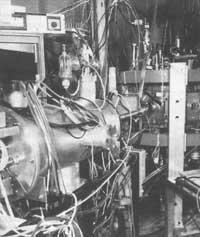
Then he passed a set of caones through the liquid hydrogen of the bubble chamber, measuring the curvature in the path of the ions, identifying in addition to the caones the muons. Let us remember that seagulls are unstable particles and their decomposition gives rise, among other things, to the formation of muons. On the other hand, the hydrogen in the chamber contained deuterium in a ratio of 1/50,000. These are the conditions that must be met for the merger process represented by Frank to occur. The conditions for Frank's merger process seem to come together in November.
But because the fusion reaction between deuterium and tritium gives more energy, scientists proposed that Frank's method could be used for the D-T reaction.
ITT. PONOMAREV and S.S. Soviet researchers GERSTEIN proposed that the D-T reaction could be catalyzed as follows: at first the muon adheres to the tritium core. If the tritium with muon is near a deuterium molecule, a kind of supermolecule would be formed in which deuterium and tritium would be joined by a muon.
Fusion occurs inside the mesomolecule, like the process described above, but there is an obvious difference: in this case the mesomolecule is formed more quickly, so fusion occurs more quickly. The Soviets then analyzed the feasibility of the process described and estimated that, before the muon disintegration, more than 100 reactions could be catalyzed. According to the theoretical calculations made, given the possibility of carrying out a process of fusion by muons, the researchers began to analyze the energy profitability of the process.
In 1983 Steven Jones and his research team conducted experiments measuring 80 D-T of marrow fusion reactions. Despite being a good quantity, it was very small from the point of view of energy profitability, since the energy spent in the process was higher than that obtained. Although there are several ways to get the muon, they are usually obtained by disintegration of the particle called pion, the most profitable and better method. Pions come from internucleon shocks, usually between carbon cores and protons. Let's say that a 5 GeV amount of energy is needed in obtaining the muon described and that of the 80 D-T fusion reactions measured by Steven Jones in his experiments, a 1.4 GeV amount of energy can be obtained. Therefore, there should be between 300 and 400 fusion reactions in the muon to make the process profitable. Here is the competition.
Physicists saw the need to improve sessions. In the sessions held by physicists at the University of Idaho, 170 mergers of the muon have been achieved and are expected to double. In addition, theoretical physicists have announced very satisfactory results and claim that, improving experiments and technique, 103 fusion reactions could be achieved in the muon. On the other hand, methods to obtain muons with a lower energy cost are being investigated.

A cold fusion?
Faced with these forecasts, other researchers working in the field of fusion have been filled with courage and have strongly begun their fusion sessions. The research objectives focus on the fusion process performed at room temperature, that is, what is currently known as cold fusion. In fact, STANLEY PONS and MARTIN FLEISCHMANN announced at a press conference held on March 23 at the University of Utah in the United States the recent merger process. These researchers completed the experiment at a temperature of 27ºC and stated that with the use of palladium and platinum electrodes they had achieved the fusion of deuterium atoms in an electrolytic tank full of heavy water (D2O).
The press conference did not give much precision and it was said that the results would be published in the journal "Nature" on May this year. The following week Steven Jones, at his lecture at Columbia University in the United States, released the latest experiments in the field of cold fusion and exposed his results S. Pons and M. They are more reliable than Fleischmann's, despite less energy.
Let's remember that Steven Jones has spent the last 5 years researching the cold fusion. Its results will also be published in the journal "Nature". Therefore, we will have to wait for May. S. Pons and M. The Fleischmann have worked for the last 40 years in the field of fusion, despite the fusion of hydrogen. Three researchers are known and in their day fusion studies were conducted in the same laboratory and together, but one knows why they separated and have been very competitive with each other.
After knowing the experiment, several researchers begin to make predictions, as already said before, S. Pons and M. Check the Fleischmann fusion process. Given the results announced by STEPHEN DEAN, co-ordinator of fusion energy researchers in the United States, Pons and Fleischmann, he has been surprised, as some physicists at Brighmann Joung University have performed the same experiment and Pons and Fleischmann have achieved no other energy. S. According to Dean, this method does not allow large amounts of energy.
ROBERT PARK, a member of the United States Physics Organization, has expressed his ignorance of how they have made their measurements. A tritium atom and a proton in the first half of the fusion phase of two deuterium atoms —R. For Park are created and in the other center is formed an atom of He (4) and a proton. The direction of the produced neutron and the energy spectra, at least due to the existence or not of a fusion. In his opinion, X-rays can cause interference as they provide the same amount of energy and direction of neutrons.
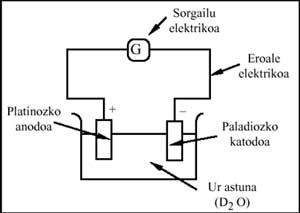
Researchers from the Atomic Energy Organization of Great Britain, under the direction of DAVID WILLIAMS, have conducted the necessary tests in recent days. Pons and M. To see the reliability of the Fleischmann program. The sessions were held in downtown Harwell and found no neutrons. In fact, the presence of neutrons is essential to demonstrate fusion. In the last 50 years the United States has spent billions of pesetas in the fusion sector. For the acceptance of the fusion of hydrogen atoms all kinds of methods have been used, such as magnetic confinement, laser. Therefore, it is not surprising that the physicist is suspicious of the results obtained by the two chemists with a very simple instrumental.
Eritzi eritzi, S. Pons and M. In order to know the incidents of Fleischmann's experiment, as has already been said, we will have to wait for the publication of the journal "Nature". But it seems like this: they pass the electric current through heavy water. The electric current dissociates heavy water with ions 0= (oxygen) and D+ (deuterium). Then, positive D+ ions target the negative palladium electrode (cathode). When a large number of D+ ions accumulate in the cathode, the other option is that the deuterium ions, being very close to the batcher, merge.
However, reaction products can be of different nature. For example, a helium core (4) and a neutral energy of 3.25 MeV can be formed. On the other hand, a tritium atom and a 4 MeV proton may form, which then reacts with a deuterium atom, giving a helium nucleus (4) and a 17,.5 MeV neutron. Researchers do not agree. Some believe that the first reaction occurs and others say it is the second. As can be seen, there is no lack of ideas and in the short term human beings will be able to control an enormous energy within the fusion process.
Finally, I would like to dedicate these last words to Particle Physics, so that the reader can look at the possibilities of using this discipline. As is known, since the discovery of the electron, proton and neutron that form the atom, other particles have been found throughout the history of physical activity (muon, caón, pion, positron, ..). When a new particle was discovered, the physicist rejoiced at the discovery that was obtained on the one hand, and on the other, they saw the world increasingly complicated. Thus particle physics was born and its use so far has been limited to cosmology and astrophysics, but we hope that it will have a practical use not only as a source of energy so necessary and practical for the human being, but also for other human needs.
Note: this article has been written in mid-April and we will try to report the news that will occur since then on this topic.
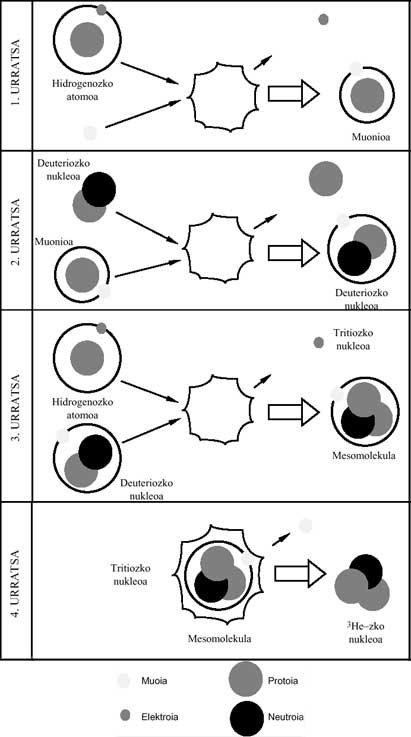
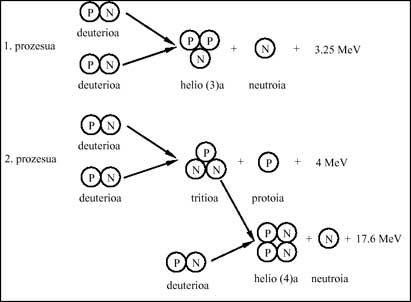

Gai honi buruzko eduki gehiago
Elhuyarrek garatutako teknologia



